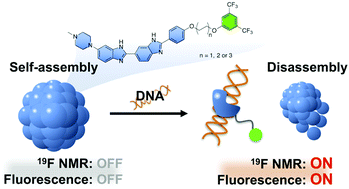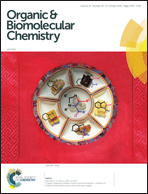Disassembly-driven signal turn-on probes for bimodal detection of DNA with 19F NMR and fluorescence†
Abstract
To image DNAs in vivo, molecular probes that can detect DNA with a highly transparent signal are required. In this study, we designed and synthesized amphiphilic molecular probes that can detect DNA with a highly transparent 19F NMR signal in a signal turn-on manner based on the self-assembly and target-dependent-disassembly of the probe molecules in aqueous solution. Fluorescence and dynamic light scattering studies revealed that these amphiphilic probes consisting of bisbenzimide H 33258 and 3,5-bis(trifluoromethyl)benzene are assembled and form aggregates in aqueous solution, and that the aggregates are collapsed when the probes bind to double-stranded DNA via selective interaction between the bisbenzimide H 33258 moiety and AATT double-stranded region of DNA. Since the target-dependent-disassembly of the probes caused turn-on of 19F NMR and fluorescence signals, bimodal detection of double-stranded DNA was successfully achieved.



 Please wait while we load your content...
Please wait while we load your content...